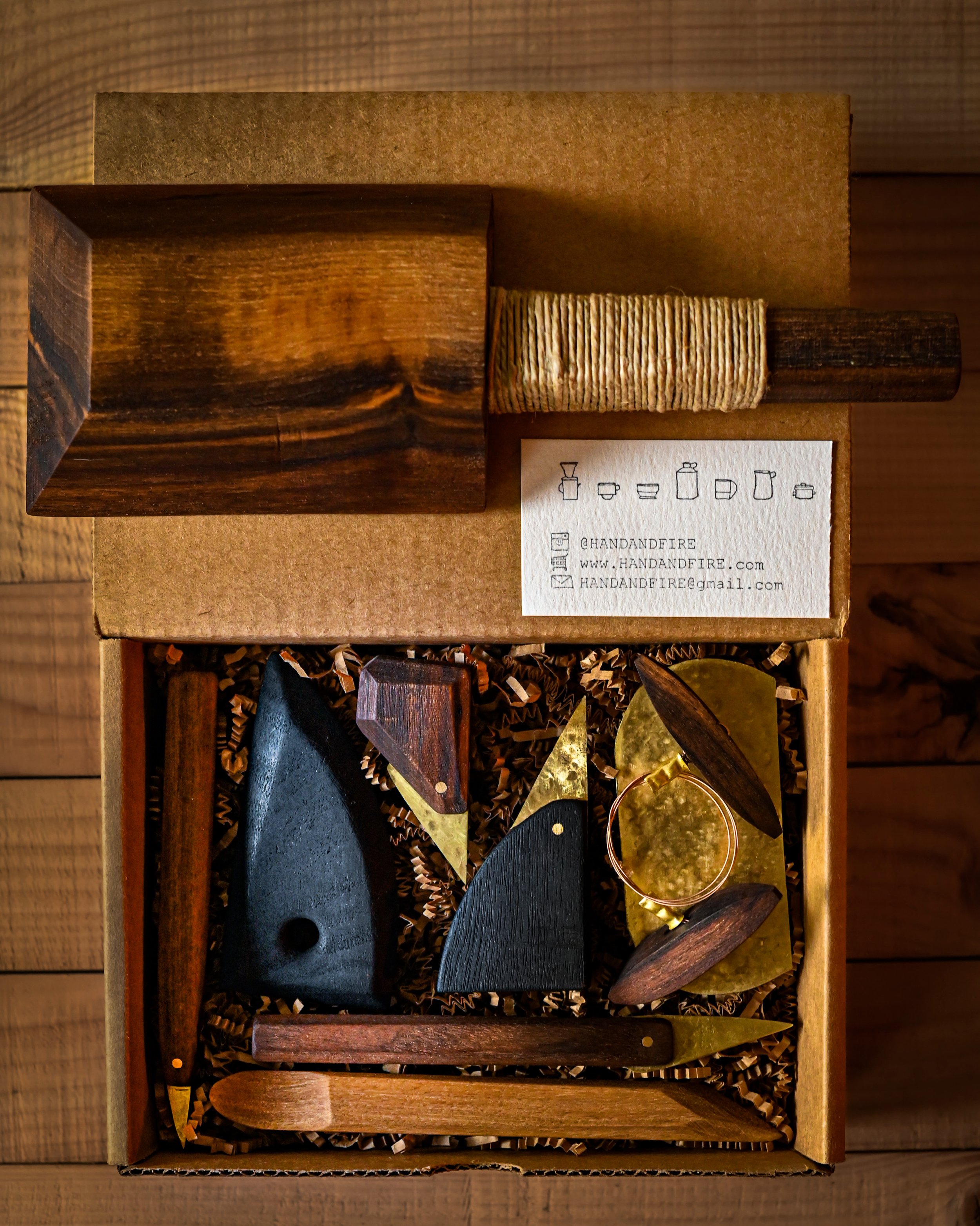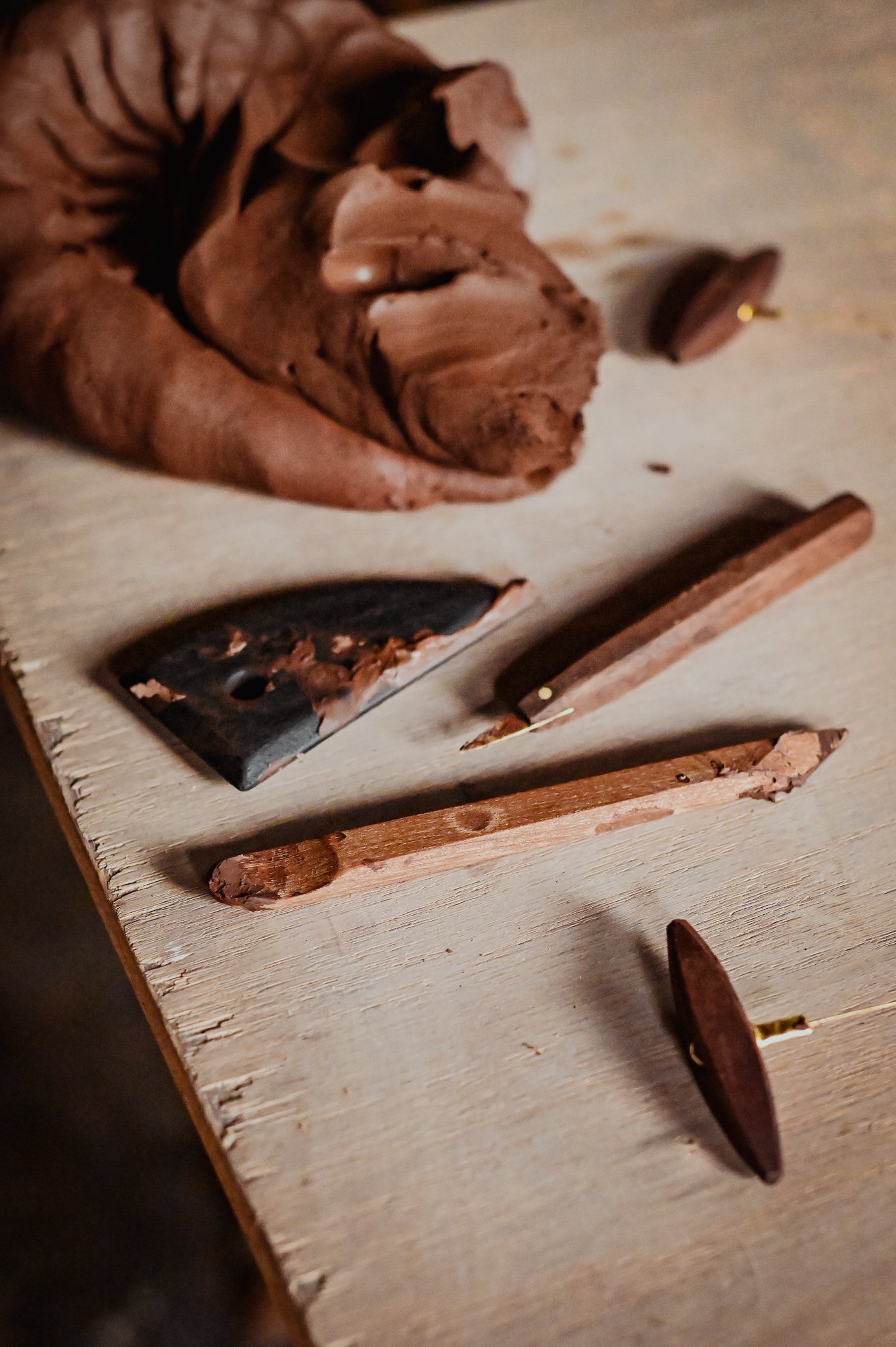Artisan pottery tools: designed and crafted by a potter. It feels good to utilize valuable tools to make valuable work, no matter how messy we are.
All H+F wooden tools are made from fallen or salvaged Oregon hardwood. This means every piece is entirely individual, bearing its own unique figuring, knots, texture, and grain. The hammering on the brass surfaces of Hand + Fire Pottery Tools is not only aesthetically pleasing, it hardens the metal to withstand gentle bending with use. Over time, a uniquely patterned patina will develop—which we think makes the tools extra special.
Handcrafted by artist, Sage Cortez


Thin, yet sturdy, these ribs are flexible enough to smooth slabs or shape pots. The hammering done to the surface is not only aesthetically pleasing, it hardens the brass to withstand gentle bending as it’s used. The texture will also allow a uniquely patterned patina to develop over time — which we think makes the tool even more special.
4” long x 2” wide
Shown freshly made, with hammered and brushed finish.
$30
For throwing, smoothing, + shaping pots.
Raw Black Walnut ribs, showing variations in color + grain.
Torched rib in use.
$31
$30
For sculpting, scraping, or rough-cutting.
Raw Black Walnut potter’s knives, showing variations in color + grain.
$28
For cutting slabs, opening boxes of clay, removing wobbly rims from pots, etc.
These knives have hand-hammered brass blades which increases their hardness + durability.
All knives in varied sizes and finishes.
$86
A torched cutter, best for slab cutting or box/letter opening. A palm held knife meant to cut quickly through a variety of materials. The largest of the bird knives.
$74
For slab work, rim cutting, and opening boxes of clay. A general-use cutting tool. The smallest of the bird knives.
$70
For rim cutting + smaller slab work. This tool will allow the best control for fine cutting.
$86
For general slab work or wobbly rim cutting. This is a sturdier knife for controlled cutting of thicker clay.
Use to cut chunks of clay off the block or remove pots from the wheel.
$35
To shape, thin, + move clay.
$95
Caring for your H+F tools:
Restoring Luster: It’s natural for wooden wares to become a bit rough after use, in order to re-hydrate your wood utensil, lightly sand the object with a 120 (or finer) grit sandpaper and use a food safe oil to rub on the surface. Allow the oil to fully saturate the wood, and let sit for an hour before buffing away with a cloth. We recommend walnut oil or bees wax board butter, which can be found at your local hardware store or supermarket. This step can be taken once every three months, as needed.
Occasionally this can happen as the wood expands and contracts when exposed to water and use. You can avoid this altogether by allowing your tools to completely dry after use and then regularly reapplying a small amount of either oil or wax to the wooden portions of the tool. Periodically, you can lightly smooth the surface of the wood using a very fine sandpaper before oiling. The more you do this, the more sealed the tool will become.
To secure it back into place, here’s some steps:
If you’ve used it recently, first let the wood and brass dry out entirely. Set it in the sun, if possible. Using a rough sandpaper, scuff up the bottom 1/4” of the brass that will be inserted into the wood and the area of wood with the holes. Then using a glue, such as super glue, gorilla glue, or epoxy, put a decent amount in each of the holes—just enough to come out the top a little when you insert the brass. Once in place (making sure to press it on tightly so it’s secure), let it sit for a day before using it again. Lastly, periodically rubbing on a bit of oil or wax to the wooden parts will help to restore the luster of the wood and waterproof it. On her personal tools, Sage uses Howard Feed-N-Wax or walnut oil—one or the other are usually available in most grocery shops.
It’ll be good as new.